19.1 The Acceleration of Fusion
(Discovering the Universe, 5th ed., §12.4)
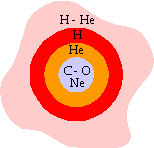 As
we saw in Lecture 17, all stars will eventually expand to become
supergiants. As
we saw in Lecture 17, all stars will eventually expand to become
supergiants.
If the star has a high mass, larger than about eight solar masses,
it will have a carbon-oxygen-neon inner core that is not burning,
surrounded by a shell of burning helium, and finally an outer
shell of burning hydrogen.
As with other stars, the core is buried deep inside the outer
layers of the star, which consist of nonburning H and He.
- With no energy source in the inner core to balance the gravity,
the star is out of mechanical equilibrium.
A high-mass star can squeeze its core more than a low-mass star
due to its larger gravity.
So, the core is again compressed, and its pressure and temperature
will rise.
The higher temperatures provide the energy for other nuclei to
fuse into new elements, provide a new source of energy in the
core, and restore equilibrium.
The most important of these reactions are detailed below, though
there are others that also provide energy and produce other elements.
In addition, many other reactions that require energy
to occur are possible at these high temperatures.
In this way every heavy element in nature is created, in proportions
that are predictable from our understanding of nuclear fusion.
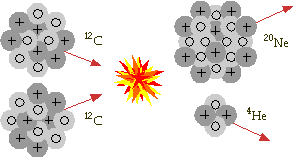
- When the temperature of the inner core reaches 600 MK, carbon fusion will begin to produce neon and helium:

With this new source of energy in the inner core, the star's
mechanical equilibrium is again restored.
However, this balance is short-lived; in a 25-solar mass star,
this process (and others) will use up most of the carbon in the
core in only 600 years!
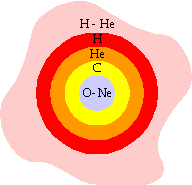
- So carbon fusion soon dies off, and the inner core becomes
primarily oxygen and neon.
Without an energy source in the inner core, the compression-shell
burning process occurs once again.
Fresh carbon produced in the upper layers of the core is pushed
deeper, and the nonburning inner core becomes surrounded by a
shell of burning carbon.
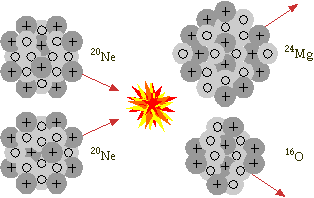
- Then the compression- heating- fusion- balance process repeats
itself in the inner core.
When the temperature of the inner core reaches 1200 MK = 1.2 GK, neon fusion will begin to produce magnesium and oxygen:

With this new source of energy in the inner core, the star's
mechanical equilibrium is again restored.
However, this balance is even shorter-lived; in a 25-solar mass
star, this process (and others) will use up most of the neon
in the core in only one year!
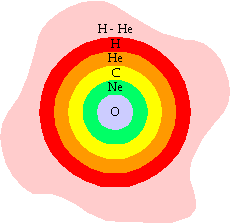
- So neon fusion quickly dies off, and the inner core now becomes
primarily oxygen.
Without an energy source in the inner core, the compression-shell
burning process occurs yet again.
Fresh neon produced in the upper layers of the core is pushed
deeper, and the nonburning inner core becomes surrounded by a
shell of burning neon.
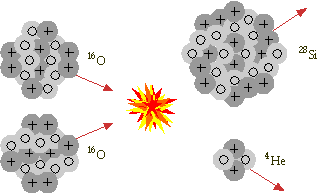
- Then the compression- heating- fusion- balance process repeats
itself in the inner core.
When the temperature of the inner core reaches 1500 MK = 1.5 GK, oxygen fusion will begin to produce silicon and helium:

With this new source of energy in the inner core, the star's
mechanical equilibrium is again restored.
However, this balance is again very short-lived; in a 25-solar
mass star, this process (and others) will use up most of the
oxygen in the core in only half a year!
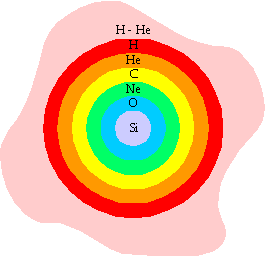
- So oxygen fusion quickly dies off, and the inner core now
becomes primarily silicon.
Without an energy source in the inner core, the compression-shell
burning process occurs once again.
Fresh oxygen produced in the upper layers of the core is pushed
deeper, and the nonburning inner core becomes surrounded by a
shell of burning oxygen.
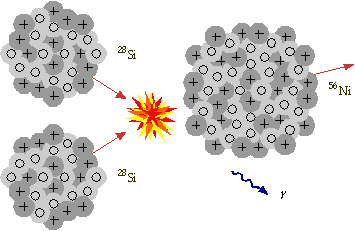
- Then the compression- heating- fusion- balance process repeats
itself one last time in the inner core.
When the temperature of the inner core reaches 2700 MK = 2.7 GK, silicon fusion will begin to produce nickel:

(Silicon fusion actually occurs through a series of reactions,
but the result is the same.)
With this new source of energy in the inner core, the star's
mechanical equilibrium is again restored.
But this balance is also ephemeral; in a 25-solar mass star,
this process will use up the silicon in the core in only one
day!

- Finally, the nickel rapidly decays into iron by neutronization,
in which protons "capture" electrons to produce a neutron
and a neutrino:

Question: where have you
seen a similar process? How did it differ?
Neutronization requires energy to occur, but such a large nucleus
can provide it from the resulting reduction in the number of
its protons.
Question: how does reducing
the number of protons provide energy?
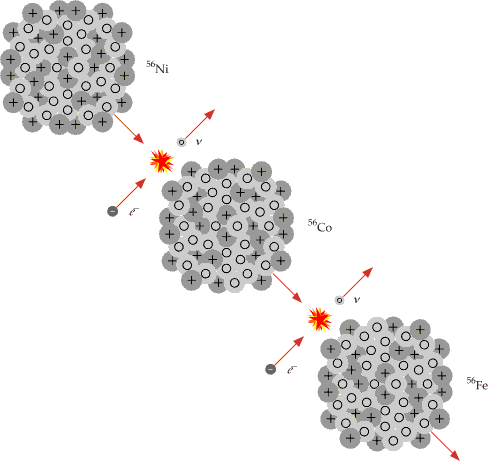
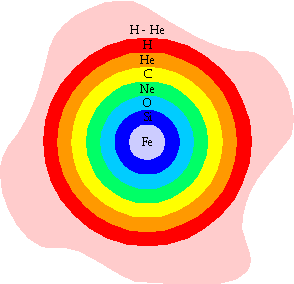
- So silicon fusion ends almost as soon as it began, and the
inner core now becomes primarily iron.
Without an energy source in the inner core, the compression-shell
burning process occurs once again.
Fresh silicon produced in the upper layers of the core is pushed
deeper, and the nonburning inner core becomes surrounded by a
shell of burning silicon.
|